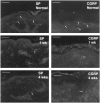Intradermal injection of capsaicin in humans produces degeneration and subsequent reinnervation of epidermal nerve fibers: correlation with sensory function
- PMID: 9787000
- PMCID: PMC6793545
- DOI: 10.1523/JNEUROSCI.18-21-08947.1998
Intradermal injection of capsaicin in humans produces degeneration and subsequent reinnervation of epidermal nerve fibers: correlation with sensory function
Abstract
The ability of capsaicin to excite and subsequently to desensitize a select group of small sensory neurons has made it a useful tool to study their function. For this reason, application of capsaicin to the skin has been used for a variety of painful syndromes. We examined whether intradermal injection of capsaicin produced morphological changes in cutaneous nerve fibers that would account for its analgesic properties by comparing cutaneous innervation in capsaicin-treated skin with psychophysical measures of sensation. At various times after capsaicin injection, nerve fibers were visualized immunohistochemically in skin biopsies and were quantified. In normal skin the epidermis is heavily innervated by nerve fibers immunoreactive for protein gene product (PGP) 9.5, whereas fibers immunoreactive for substance P (SP) and calcitonin gene-related peptide (CGRP) are typically associated with blood vessels. There was nearly complete degeneration of epidermal nerve fibers and the subepidermal neural plexus in capsaicin-treated skin, as indicated by the loss of immunoreactivity for PGP 9.5 and CGRP. The effect of capsaicin on dermal nerve fibers immunoreactive for SP was less obvious. Capsaicin decreased sensitivity to pain produced by sharp mechanical stimuli and nearly eliminated heat-evoked pain within the injected area. Limited reinnervation of the epidermis and partial return of sensation occurred 3 weeks after treatment; reinnervation of the epidermis was approximately 25% of normal, and sensation improved to 50-75% of normal. These data show that sensory dysfunction after capsaicin application to the skin results from rapid degeneration of intracutaneous nerve fibers.
Figures






Similar articles
-
Topical capsaicin in humans: parallel loss of epidermal nerve fibers and pain sensation.Pain. 1999 May;81(1-2):135-45. doi: 10.1016/s0304-3959(99)00007-x. Pain. 1999. PMID: 10353501
-
Influence of thermode size for detecting heat pain dysfunction in a capsaicin model of epidermal nerve fiber loss.Pain. 2001 Apr;91(3):241-250. doi: 10.1016/S0304-3959(00)00444-9. Pain. 2001. PMID: 11275380 Clinical Trial.
-
Shock wave application to rat skin induces degeneration and reinnervation of sensory nerve fibres.Neurosci Lett. 2001 Nov 23;315(1-2):57-60. doi: 10.1016/s0304-3940(01)02320-5. Neurosci Lett. 2001. PMID: 11711214
-
Final report on the safety assessment of capsicum annuum extract, capsicum annuum fruit extract, capsicum annuum resin, capsicum annuum fruit powder, capsicum frutescens fruit, capsicum frutescens fruit extract, capsicum frutescens resin, and capsaicin.Int J Toxicol. 2007;26 Suppl 1:3-106. doi: 10.1080/10915810601163939. Int J Toxicol. 2007. PMID: 17365137 Review.
-
Capsaicin: Physicochemical properties, cutaneous reactions and potential applications in painful and inflammatory conditions.Exp Ther Med. 2019 Aug;18(2):916-925. doi: 10.3892/etm.2019.7513. Epub 2019 Apr 19. Exp Ther Med. 2019. PMID: 31384324 Free PMC article. Review.
Cited by
-
Objective evidence that small-fiber polyneuropathy underlies some illnesses currently labeled as fibromyalgia.Pain. 2013 Nov;154(11):2310-2316. doi: 10.1016/j.pain.2013.06.001. Epub 2013 Jun 5. Pain. 2013. PMID: 23748113 Free PMC article.
-
Biological Properties, Bioactive Constituents, and Pharmacokinetics of Some Capsicum spp. and Capsaicinoids.Int J Mol Sci. 2020 Jul 22;21(15):5179. doi: 10.3390/ijms21155179. Int J Mol Sci. 2020. PMID: 32707790 Free PMC article. Review.
-
Targeting TRPV1 activity via high-dose capsaicin in patients with sickle cell disease.EJHaem. 2022 Jul 19;3(3):653-659. doi: 10.1002/jha2.528. eCollection 2022 Aug. EJHaem. 2022. PMID: 36051054 Free PMC article.
-
Nonlinear Inverted-U Shaped Relationship Between Aging and Epidermal Innervation in the Rat Plantar Hind Paw: A Laser Scanning Confocal Microscopy Study.J Pain. 2018 Sep;19(9):1015-1023. doi: 10.1016/j.jpain.2018.04.002. Epub 2018 Apr 13. J Pain. 2018. PMID: 29660414 Free PMC article.
-
Capsaicin: Friend or Foe in Skin Cancer and Other Related Malignancies?Nutrients. 2017 Dec 16;9(12):1365. doi: 10.3390/nu9121365. Nutrients. 2017. PMID: 29258175 Free PMC article. Review.
References
-
- Baumann TK, Simone DA, Shain CN, LaMotte RH. Neurogenic hyperalgesia: the search for the primary afferent nerve fibers that contribute to capsaicin-induced pain and hyperalgesia. J Neurophysiol. 1991;66:212–227. - PubMed
-
- Bevan SJ, Docherty RJ. Cellular mechanisms of the action of capsaicin. In: Wood J, editor. Capsaicin in the study of pain. Academic; London: 1993. pp. 27–44.
-
- Buck SH, Burks TF. The neuropharmacology of capsaicin: review of some recent observations. Pharmacol Rev. 1986;38:179–226. - PubMed
-
- Capsaicin Study Group. Arch Intern Med. 1991;151:2225–2229. - PubMed
Publication types
MeSH terms
Substances
Grants and funding
LinkOut - more resources
Full Text Sources
Other Literature Sources
Medical
Research Materials
Miscellaneous
